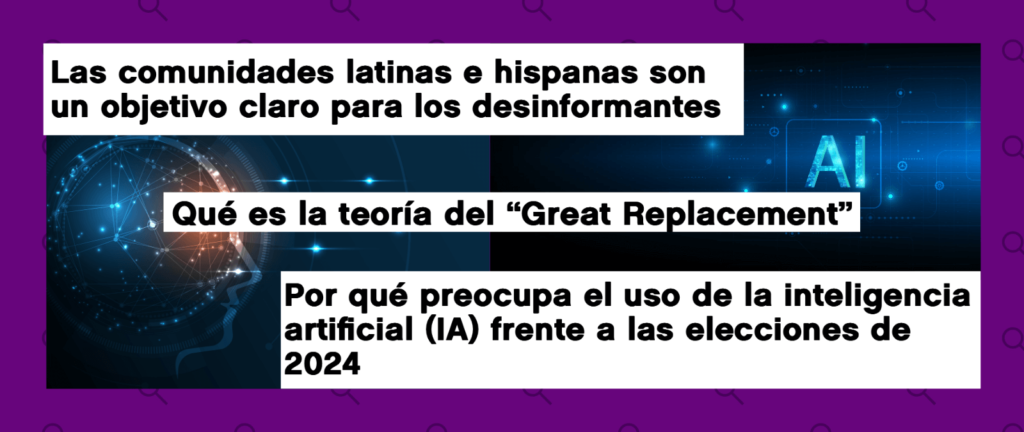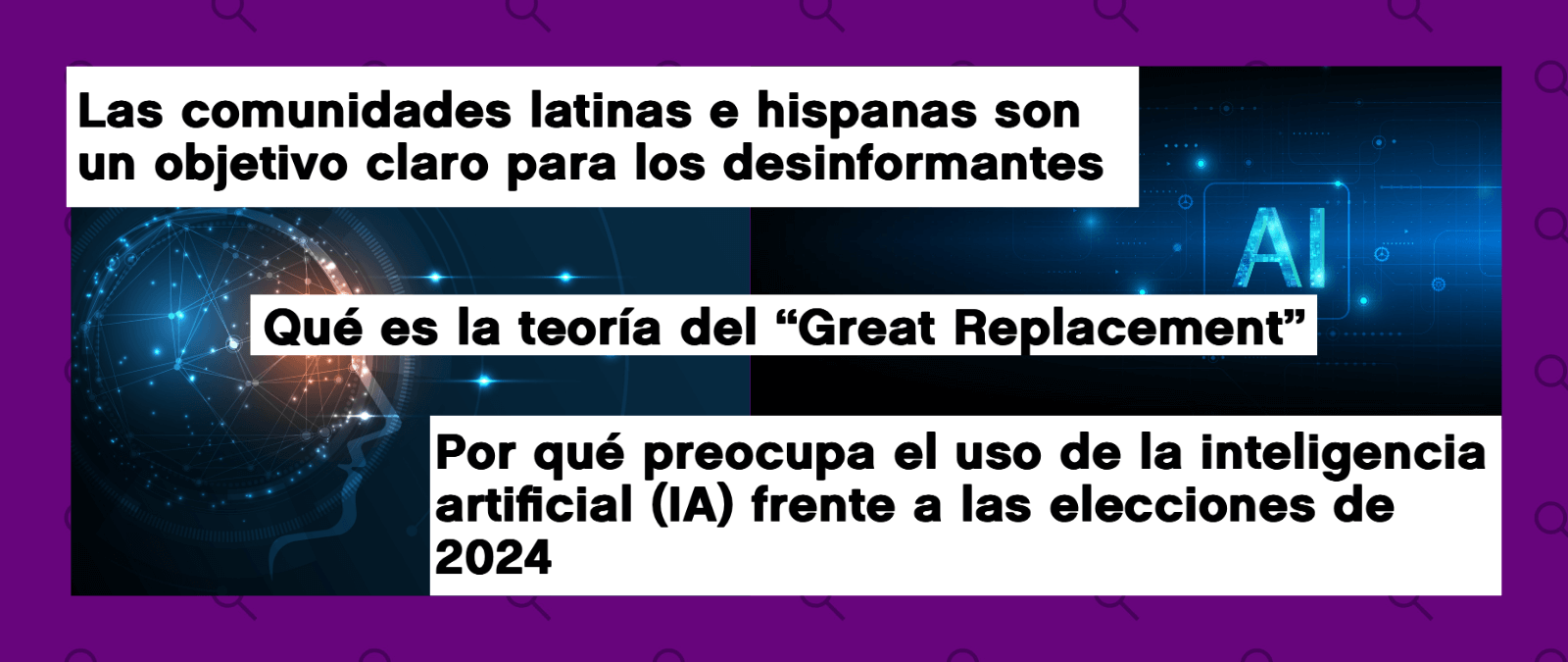If you only have a few seconds, read these key takeaways:
- This will be the first presidential election with easy-to-use artificial intelligence tools available to anyone who wants to try manipulating voters in 2024.
- WhatsApp is a preferred way Latinos communicate, and for some, it’s one of the preferred platform for consuming news. However, it’s also a platform through which mis- and disinformation spreads.
- There are false narratives affecting Latino communities that resurface in every electoral process, such as claims that the border is open, that there is a connection between immigration and an increase in crime rates, and that some non-U.S. citizen immigrants can vote.
By the Factchequeado Team

On November 5, 2024, Americans will choose a new president. During the election season, mis- and disinformation gains more strength, reaches more people, and can ultimately influence voting.
Puedes leer este artículo en español
At Factchequeado, we don’t have a crystal ball. In fact, if there’s something we can’t fact-check, it’s the future. However, we can prepare ourselves based on what we’ve learned with previous elections, so that mis- and disinformation doesn’t catch us – or you – off guard.
Below are six key areas that we’re paying attention to during this 2024 election cycle:
1. Artificial Intelligence (AI) and its role in campaigns
This will be the first presidential election during which AI tools are widely available to generate fake images, videos, or voices.
In 2023, we saw AI used for electoral purposes in two main instances in the U.S.:
1 – In April 2023, the Republican Party used AI to create a video critical of President Joe Biden, who is a member of the Democratic Party, after he announced he would seek reelection. The video shows chaotic images of war and crime. However, it is important to note that this campaign ad made it clear from the start that the images were generated with AI.
2 – In June 2023, the campaign of Republican presidential candidate Ron DeSantis published a video that included a collage of images of Donald Trump with the former director of the National Institute of Allergy and Infectious Diseases, Anthony Fauci. The publication combined real photos with images created with AI, showing Trump apparently hugging and kissing Fauci. In this case, DeSantis’ campaign did not note anywhere in the ad that the images of Trump embracing Fauci had been created with AI.
Those are just two examples of the use of AI by political organizations in the United States. However, we know that AI is an easy-to-use tool available to anyone who wants to try to manipulate voters in 2024. That’s why, at Factchequeado, we are preparing ourselves to debunk any content created with AI as quickly as possible. At the same time, we also are dedicated to teaching the broader community tips and tools to detect AI, so that community members can protect themselves, making us all less vulnerable to these new AI disinformation techniques.
At the same time, we are concerned that political leaders may try to convince their followers that something has been created with AI when it is, in fact, a real video. In December 2023, Donald Trump claimed that Project Lincoln (a Republican organization against Trump) had posted videos created with AI to make him look bad. PolitiFact, a Factchequeado media partner, verified that what Trump said was false: Project Lincoln’s videos used real photos and images of Donald Trump.
2. WhatsApp, the messaging app most used by Latinos where mis- and disinformation in Spanish often spreads
It could be an uncle, aunt, or anyone else in the “family group chat,” a former classmate, colleague, or anyone else in the “friend group chat.” WhatsApp is how Latinos communicate, and according to a report by Equis Research, it is also one of the platforms Latinos prefer to use to consume news. However, it is also a platform through which mis- and disinformation spreads. The challenge is that, since it is not a social network, but a private instant messaging platform, effectively monitoring mis- and disinformation shared there requires the help of our community.
If you receive content on WhatsApp that looks suspicious, please forward it to Factchequeado at +1 (646) 873 60 87 so that we can verify it.
3. Election disinformation created in Spanish, targeting Spanish speakers
The Latino vote could be a deciding factor in the 2024 presidential election., At Factchequeado, we are preparing for scenarios similar to what we saw in Georgia during the 2022 midterm elections: disinformation created in Spanish to target Latino communities.
In October 2022, members of the community informed us that postcards were circulating in mailboxes in predominantly Hispanic areas of Georgia, showing an adult man entering a bathroom where a girl was washing her hands. The image was accompanied by this message in Spanish: “Joe Biden and his ‘progressive’ allies (sic) in Washington want men to use girls’ bathrooms in grades K-12 (kindergarten to high school).”
The message was paid for by the America First Legal Foundation (an organization chaired by Stephen Miller, former advisor to former President Donald Trump), and was false: the Biden administration has not proposed a policy for adult men to enter girls’ bathrooms in schools.There is also no data establishing a correlation between inclusive bathroom access policies and an increase in cases of harassment or sexual violence.
However, this case, where money and time were invested in designing a pamphlet in Spanish with the intent to disinform people, shows that the Latino vote in swing states is important. It also shows that disinformation not only spreads through social media, the radio, or television, it can also spread through regular mail.
4. X (formerly Twitter,) because it is now less reliable
X is now a more chaotic place than before: a blue checkmark next to an account is no longer synonymous with the authenticity of the user, and the amount of mis- and disinformation, as well as hate speech on the platform, has increased.
According to research published in September 2023 by the Center for Countering Digital Hate, out of 300 posts with hate messages reported by the organization, X only removed 14%. The messages, according to the research, included posts promoting racism, antisemitism, and neo-Nazism.
This research coincides with the fact that Elon Musk, the new owner of X, has not only fired the teams responsible for content moderation, but has also spread misinformation and conspiracy theories himself.
X is not the only platform that has reduced its number of content moderators. Meta (the company that owns Facebook and Instagram) also reduced the amount of staff dedicated to monitoring and combating misinformation on its platforms in 2023. Little is known about what happens on TikTok.
5. The resurgence of well-known (and debunked) false narratives affecting Latino communities
Ahead of the 2024 elections, below are some false narratives that we’ve seen before and we see circulating again:
False claims of election fraud: A false narrative promoted by Trump and his allies since his 2020 defeat, which is still a part of Trump’s political discourse.
Anti-immigrant narratives and mis- and disinformation about the border: With the arrival of more migrants at the U.S. southern border, we have recorded an increase in mis- and disinformation on the topic. It is important to keep in mind that it is false that the border is open, that there is no connection between immigration and an increase in the crime rate, and that the “Great Replacement” is a conspiracy theory that suggests there is a plot to replace the political and cultural power of the white population of the West with migrants from other ethnic origins. Also, watch out for content that claims that immigrants who are not U.S. citizens can vote, because that is false.
We will also say vigilant about analyzing the statistics politicians mention related to the number of border crossings happening. We have already seen that, on occasion, politicians equate encounters with migrants at the border with the number of individuals who have crossed the border. In reality, one migrant can lead to multiple encounters if they cross the border more than once.
It is not true that crime is at historic levels: As Factchequeado reported before, while overall violent crime increased in 2020 in the U.S., the figures for 2020 were below what was recorded in the 1990s. Additionally, according to FBI figures, between 2021 and 2022, overall violent crime decreased by 1.7%. Experts recommend being cautious when politicians highlight large cities as the most dangerous places – there are rural cities with rates up to 3 times higher than those of New York, for example.
Manipulation of economic numbers: This is a disinformation technique in which politicians interpret and present economic figures and sometimes leave out key context. For example, in September 2023, we saw the Biden campaign use the low unemployment rate in political messages targeting Latinos. However, the lowest Hispanic or Latino unemployment rate was indeed recorded in 2022 during the Biden administration, but by September 2023 (when the ad was released), the unemployment rate was 4.6%. That is slightly higher than the rate recorded in September 2019 (before the COVID-19 pandemic) during the Trump administration, when it stood at 4%.
6. The trials against Donald Trump
We cannot rule out that during the election cycle, there may be hearings or rulings related to the trials facing Donald Trump. Whatever happens in those legal proceedings may become incorporated into election campaigns.
To avoid falling into mis- and disinformation on the topic, you can read below what each case is about:
Key points of the criminal charges against Trump in the classified documents case
Factchequeado is a fact-checking platform growing a Spanish-speaking community of partners to counter mis- and disinformation in Spanish in the United States. Do you want to join us? Verify the content you receive by sending it to our WhatsApp +1 (646) 873 60 87 or to factchequeado.com/whatsapp
